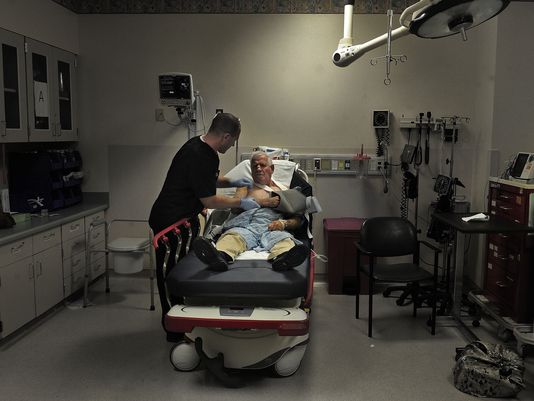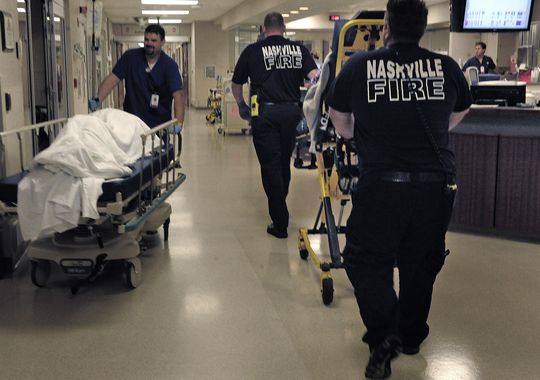
A grisly headshot of Walter White, the anti-hero of "Breaking Bad," glares from two computer monitors on the desk of Mike Schatzlein, the CEO of Saint Thomas Health, one of Nashville's major health care systems. The TV character's meth-cooking ways don't exactly line up with Saint Thomas' mission of faith-based care, Schatzlein joked, but he still loves a good show.
Schatzlein took the helm at Saint Thomas three years ago, just in time to pilot the system through some drama of its own - namely, the Affordable Care Act and federal health reform.
Today, hospitals across the country must transform to survive.
It may seem obvious, but hospitals remain major hubs of American health care. More than 35.1 million people were discharged from inpatient care at non-federal hospitals in 2010, according to a report from the Centers for Disease Control and Prevention. There were more than 100 million outpatient department visits and almost 130 million visits to emergency departments in this country.
No one can say exactly how the Affordable Care Act, also known as "Obamacare," will affect hospitals.
Should the act help more people access insurance, hospitals could get paid for charity care that they now provide for free to uninsured patients.
However, the ACA also could flood hospitals with new, high-use patients, which could tax already overburdened physicians and hospital staff. In addition, hospitals also could receive less money for the same services in the short term: The government has outlined plans to cut reimbursement rates for patients on Medicare.
Hospital administrators and employees are worried, with good reason.
Amid the uncertainty in the industry, one thread remains clear: Hospitals will, in the future, exist in a world where they are rewarded more for the quality of care than for the volume of patients they treat. As this transition occurs, hospitals must live in two worlds - one where they still earn money per procedure and another that views the treatment of patients in a more holistic way, with successful outcomes the most important measure of a hospital's performance.
"We have to understand that today, we are still paid for volume," said Kevin Locke, managing partner of CPA firm Dixon Hughes Goodman, who helps clients navigate ACA-related reimbursement issues. "As we migrate from that system to one that pays for value, we have to stay financially solvent. It's figuring out that puzzle in the middle."
Saint Thomas Health, Vanderbilt University and TriStar Centennial are among the Nashville providers navigating this sea change now. Each has its own structure and strength. Each has unique challenges to face.
Saint Thomas Health includes five facilities. It's the Tennessee branch of a larger nonprofit, nationwide Catholic health system called Ascension, which spans 23 states. TriStar Centennial is the Nashville-based flagship hospital of TriStar Health, a Southern branch of HCA, the largest for-profit hospital company in the country. Vanderbilt University Medical Center is a nonprofit teaching hospital. It's part of Vanderbilt University, Nashville's largest private employer.
Rewards, penalties
Administrators at all three facilities talked about how they are tackling quality. None were too keen to link their quality initiatives to the Affordable Care Act. Part of that is because the term "Affordable Care Act" sparks an emotional reaction.
In fact, in terms of quality, the ACA doesn't carry many rules. It allows hospitals to create entities called accountable care organizations, third-party groups that oversee the quality of care at hospitals.
The ACA says the government will offer financial incentives to hospitals that perform well. The government determines good performance through a combination of clinical outcomes and patient satisfaction surveys.
The ACA also will penalize hospitals that appear to perform poorly. As of last October, the government started cutting Medicare reimbursement for hospitals with readmission rates considered excessive. In 2015, hospitals that still have high rates of hospital-acquired infections will see a further reimbursement rate cut.
The ripple effect of the ACA, however, is larger than the sum of its parts, according to Gerald Hickson, Vanderbilt's vice president for quality safety and risk prevention. "The one thing health reform has done is it has changed the way we're thinking," he said. "That's where change begins, and it has begun."
Vanderbilt does not have shareholders monitoring its spending, but it must keep a close eye on costs. In September, Vanderbilt notified state and federal government officials that the medical center will cut more than 1,000 jobs by the end of the year to prepare for economic uncertainties, some of which are due to health care reform.
Vanderbilt also is, primarily, a research hospital. This means it plays a unique role in the volume-to-quality shift, Hickson said, in that it can study best practices going forward.
Though it can contribute significant brainpower, Vanderbilt faces certain challenges shifting to a quality-based payment system. For one, academic medical centers are sometimes complex and slow to change. Also, the government might have difficulties accurately monitoring the quality of care and readmission rates at a place like Vanderbilt, which has the only Level I trauma unit in the region and treats a higher proportion of serious injuries.

TriStar Health is a different animal. It's made of 14 hospitals in Middle Tennessee and Kentucky, including TriStar Centennial, the network's flagship hospital. TriStar Health sits under the HCA umbrella. HCA is a major for-profit corporation.
HCA's hospitals are well situated in that they can implement systemwide changes quickly. "When a patient is less than satisfied with their experience - say there's a complaint about too much noise in the hallway - we process that, and (it's) read by a CEO," said Jeffrey Guy, the chief medical officer at TriStar Health. "And that's how organizations get better."
HCA also has shareholders watching its stock, which can be a mixed blessing. Internally, HCA hospitals and hospital systems are each pursuing quality in their own ways, then can share best practices across the network. But externally, shareholders aren't pestering the CEO about reduced infection rates. In fact, said Michael Waterhouse, a health care equity analyst for Morningstar, quality doesn't quite make it into the earnings calls.
"I think if you distilled HCA's strategy to just a few brief points," Waterhouse said, "it would be guaranteeing as much volume as possible, offering good services, having as much market share as possible, and, if you are signing people up through exchanges, making sure you're getting that guaranteed exchange volume."
At Saint Thomas
And then there is Saint Thomas. CEO Mike Schatzlein believes he is in the sweet spot: running a nonprofit with the institutional support of the Ascension network, but without shareholders or a cumbersome academic institution on his back.
"There are some provisions in the ACA that permit us to collaborate with doctors in ways that we couldn't before," he said. For example, Saint Thomas has set up MissionPoint, which works like an ACO. At first, MissionPoint included only Saint Thomas employees and their dependents, but now it monitors care for 80,000 people. It is run by a board of physicians and enables doctors to follow up on patients who have visited the ER, for example, and check that they take their medicine or properly dress their bandages. Simply calling, Schatzlein said, goes a long way toward reducing expensive re-admissions.
Those calls touch on a major confounding variable in terms of hospitals' shifting from volume to quality - that is, of course, the patients, many of whom believe that more care is better care.
Take heart surgery. Schatzlein used to do a certain operation for patients at risk of stroke. When he explained to people that, statistically, the evidence suggested the risk was the same whether the patient had an intrusive operation or took an aspirin every day for the next 20 years, people overwhelmingly chose the procedure.
Of note, the Affordable Care Act does not really take patient behavior into account. It does not outline the path forward for hospitals. But it is happening now.
"What's cool about this is that all of a sudden the country needs what faith-based Catholic health care was designed to provide, which is holistic reverent care across the spectrum of time and space," Schatzlein said.
Source: The Tennessean



Reader Comments
to our Newsletter